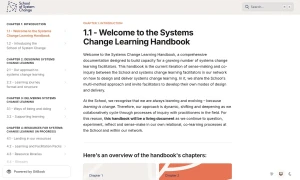This piece draws on content from the School’s Systems Change Learning Handbook and acknowledges its co-authors: Anna Birney, Rachel Phillips, Rachel Maria Taylor, Saskia Rysenbry, Sean Andrew and other collaborative partners at the School, notably Laura Winn and Payam Yuce Isik.
We are grateful to Cisco Foundation for supporting the School with a Global Impact Grant, which enabled the writing and publication of the Systems Change Learning Handbook.
A year and a half ago, I joined the School of System Change as Knowledge Manager. My role is to support the sharing of knowledge, resources and assets across the School’s many audiences and learning spaces.
As I joined, the School was embarking on a project to write a handbook intended to play a fundamental role in realising our theory of change. This blog shares the process we went through to map, write, edit and publish the handbook, as well as some of our learnings.

Why a Handbook?
At the School we believe that the transformation needed for a just and regenerative future can be catalysed by building people’s collective ability to embrace and work with complexity in our changing world.
We are a small enabling team working in a distributive network model. Our ambition is to enable systems change through irrigation: getting the water of systems learning and practice out into the world in a way that doesn’t necessarily involve scaling our team or increasing our costs.
As such, the handbook documents and shares the School’s approach, so that a growing number of facilitators can take it up, ripple it out and build capacity in their networks, organisations, geographies and contexts.
The Process
As someone new to the School and its ways of organising, the process of working on the handbook was fascinating, both in terms of what we were discussing and writing, and how we were going about doing it.
We began with big, broad conversations about overall content: what we had, what we were missing. We discussed the order these ideas might come in to make most sense to an outside audience, and eventually found our way to an overall structure of four chapters, detailed below as an appendix.
Our cycles of working became tighter as we formed a writing circle of members of the Enabling Team — Anna, Sean, Saskia and me — and collaborative partners — Rachel Phillips, Co-Founder and Principal Consultant at Edge Effects and a long term facilitator and coach with the School and Rachel Maria Taylor, narrative and editorial strategist, story experience designer, editor and writer, who played a pivotal role in shaping each text and weaving the handbook as a coherent whole.
Together, we organised 39 individual ‘entries’ over the four chapters, and gave each one a primary writer. We developed a central spreadsheet with a corresponding Drive folder structure to track the progress of each entry.

For complex entries, like trying to pin down how the School applies a multi-method approach or the role of action inquiry in our work, we recorded ‘roundtable’ conversations and voicenotes, which Rachel Taylor would then synthesise into a nuanced text. This was a process that emerged and that we learnt as we moved through the project, that built on earlier rounds of iterating, testing and learning by Saskia and Rachel T.
Once we had an initial draft for each entry, it entered a multi-stage process of editing, where other members of the circle would test whether the text was true to their understanding of the School’s work and integrate any missing perspectives or ideas, and then Rachel Taylor would work on wordcraft, ensuring consistency and the right emphasis on core aspects of the School’s approach across the whole handbook.
In a parallel process, I also worked with Anna and Saskia to develop a number of diagrams and prepare for the publication of the handbook on Gitbook in a way that would promote easy navigation and an excellent user experience.
By the end of the process, we had co-authored 40,000 words.
Learnings
Joining the handbook project was a lucky experience as I was stepping into my new job — as well as having my own deep and fast-tracked introduction to the School and systems change, I entered an unusual collective learning experience, where a whole group of us with different depths of understanding and experience were learning about the School and systems change learning together.
Here are some insights.
1. Our learning content = framing + methods
One of the most satisfying parts of the writing process for me was working with Rachel Taylor to clarify our language around the content we deliver on our learning programmes.
When I joined the School, we were using the umbrella of a “multi-method approach” to describe what we teach. I always found it confusing to refer to concepts we share like ‘healthy power’ and ‘systemic worldviews’ as methods in the same way as we might frameworks like Cynefin or the Iceberg Model. As we co-authored the chapter on learning journey design, we dug deep into these terms, and introduced some new ones for clarity.

Now we talk about learning content, a combination of:
- Framings:Core framings that support the introduction and navigation of a multitude of methods and our participants’ development of systems change capabilities. Eg. Power or systemic worldviews.
- Methods:
Quoting from the Handbook: ‘Across the fields of systems change, there is a wealth of approaches, methodologies, tools, processes, practices and frameworks that involve diverse and intersecting concepts, theories, ideas, cultural contexts, systemic worldviews and lived experiences. At the School, we collectively call these “methods”. We believe that there is no one way to do systems change. This is why we take a multi-method approach. Throughout our learning journeys, facilitators introduce multiple methods and make participants aware of the diverse methods being developed, adapted and used in different contexts in the field.’ - Contributors:
The systems change practitioners who contribute to learning journeys. They bring our multi-method approach to life by sharing their experience, stories and knowledge of methods, demonstrating the multiplicity of the fields of systems change practice.
2. A systemic way of writing
At the end of the writing process, when the full handbook had been published on Gitbook and shared with our Network, members of the writing circle came together to reflect on the process.
One thing that we all shared was the sense that the way we wrote the handbook was a systemic process in itself: participatory, emergent and multiple. Rather than asking individual writers to write individual sections of the text, we all participated in writing first, second and third drafts, using regular meetings and asynchronous space on Slack to fill in gaps and test the meaning.

I really appreciate the feeling of co-authorship and multiple minds and hands on the text — also recognising that so much of what is in the handbook draws on a greater pool of knowledge and experience, beyond that of our writing circle.
In a culture that buys so deeply into the myth of the individual and the [white, male] genius, it felt beautiful and refreshing to let go of ownership over any particular portion of the text. It felt like it represented what organisations — and most things in this world — really are: a tapestry of many people’s work.
3. The handbook as a living system
As a result, I believe the handbook itself can be seen as systemic. The School recognises that systems share four qualities: they are nested, interconnected, emergent and alive.
Each individual entry can be read as a standalone text, nested within chapters and woven with connections to other entries. Multiple sweeps of editing by Rachel T and Saskia ensured essential themes and emphases were woven through the whole handbook. If an idea changed in one place, it was updated everywhere.
We expect there to be a symbiotic relationship between how the text evolves alongside the School’s approach. We can already feel ourselves growing into the confidence and clarity that writing the handbook helped to cultivate — which feels like a beautiful incarnation of the School’s core belief that ‘learning is change’. And while we believe that Chapters One to Three will have a relatively slow pace of change, Chapter Four is intended to be alive: continually and dynamically updated as the enabling team and our partners create and iterate School resources.
Moreover, the handbook invites facilitators to craft their own modes of systems change learning while embodying the School’s approach. By engaging with the handbook, facilitators become involved in a co-inquiry process, which in turn deepens and strengthens our collective work in the field.
What's next
We have shared the handbook with our collaborative partners, and it is being used to shape the facilitation of this year’s programmes — both open enrolment and bespoke offers to organisations. We are in the process of scoping and understanding how we want to share the handbook with a wider audience.
If you are interested in accessing the handbook or in partnering with the School to design and deliver transformative learning experiences in your network, organisation, geography or context, please get in touch: [email protected].
Appendix: Content overview
The handbook’s content is as follows:
Chapter One: Introducing the Handbook and the School of System Change
In this chapter, we share why we wrote the handbook, introduce who we are at the School: our theory of transformation, our principles, our understandings of systems change, our approach to equity and difference and our Learning Commons.
Chapter Two: Designing systems change learning
Our approach to systems change learning
This subchapter lays out our approach to designing systems change learning: our four foundational learning outcomes for all learning journeys at the School, and the seven capabilities that we believe all systems change practitioners should foster and possess. We also unpack the integral elements of our approach and discuss how to involve action inquiry, social learning, practice-based development and equity and difference in learning journeys.
Learning journey format and structure
Here we delve deeply into the design process of creating a learning journey, from mapping out the journey arc to designing the individual sessions. To accompany this process, we developed a Systems Change Learning Journey Design Canvas, a practical Miro board template for facilitators to work with.
Chapter Three: Delivering systems change learning
Ways of being and doing
In this subchapter, we explore facilitation as systemic practice, peering through the lens of action inquiry as a way of being and doing. We highlight certain capabilities and capacities we believe facilitators must nurture, to:
- Be able to do the inner work and recognise their power and positionality
- Co-host with teams
- Facilitate and navigate group dynamics
- Support learning and practice development
- Support the navigation of multiple methods of systems change practice
Supporting learning
Here we share the many ways that facilitators can support participants during the learning journey and in their systems change practice beyond it.
Chapter Four: Resources for systems change learning
Our ambition with Chapter 4 is to support the design and delivery of a wide range of systems change learning experiences via our Learning and Facilitation packs (gateways to up-to-date framings, resources and assets shared by the School to help form different systems change learning experiences) and Resource Libraries.





